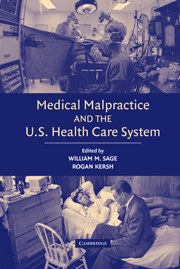Book contents
- Frontmatter
- Contents
- List of Contributors
- Introduction
- PART ONE FRAMING MEDICAL MALPRACTICE AS A HEALTH POLICY ISSUE
- PART TWO THE HEALTH POLICY IMPACT OF MEDICAL MALPRACTICE
- PART THREE MALPRACTICE REFORMS THAT SOLVE THE RIGHT PROBLEMS
- PART FOUR IN SEARCH OF A “NEW PARADIGM”
- 12 Enterprise Liability in the Twenty-First Century
- 13 Private Contractual Alternatives to Malpractice Liability
- 14 Medical Malpractice Insurance Reform: “Enterprise Insurance” and Some Alternatives
- 15 Governments as Insurers in Professional and Hospital Liability Insurance Markets
- 16 Medicare-Led Malpractice Reform
- Bibliography
- Index
12 - Enterprise Liability in the Twenty-First Century
Published online by Cambridge University Press: 10 December 2009
- Frontmatter
- Contents
- List of Contributors
- Introduction
- PART ONE FRAMING MEDICAL MALPRACTICE AS A HEALTH POLICY ISSUE
- PART TWO THE HEALTH POLICY IMPACT OF MEDICAL MALPRACTICE
- PART THREE MALPRACTICE REFORMS THAT SOLVE THE RIGHT PROBLEMS
- PART FOUR IN SEARCH OF A “NEW PARADIGM”
- 12 Enterprise Liability in the Twenty-First Century
- 13 Private Contractual Alternatives to Malpractice Liability
- 14 Medical Malpractice Insurance Reform: “Enterprise Insurance” and Some Alternatives
- 15 Governments as Insurers in Professional and Hospital Liability Insurance Markets
- 16 Medicare-Led Malpractice Reform
- Bibliography
- Index
Summary
For decades health policy advocacy and analysis have tried to solve two apparently separate and seemingly intractable problems. First, physicians and other providers can face extreme difficulties in obtaining and financing malpractice insurance – and periodic insurance crises demand policy makers' attention. Second, preventable injuries to patients occur all too frequently in the course of health care. This continuing reality received new prominence from the Institute of Medicine's (IOM's) landmark 2000 book To Err Is Human, which also described new methods of systematically promoting patient safety.Reformers have long proposed a shift from individual to enterprise liability, both to improve the efficiency and operations of liability insurance and to enhance patients' safety. This chapter examines the theory of and the prospects for institutional liability, given recent evolution of tort law and of medical service delivery.
TODAY'S POLICY CONTEXT
The malpractice insurance crisis proclaimed in the early 2000s is the third in thirty years. For several years, many practitioners in many states had to scramble for coverage or struggle to afford what they find.Physicians typically must have insurance coverage to practice; coverage is normally required by hospitals as a condition of privileges, by managed care organizations as a condition for inclusion in provider networks, and occasionally even by states as a condition of licensure, as in Pennsylvania.Like the past two, this crisis has been more severe and longer lasting for medical liability than for other types of property-casualty insurance.
- Type
- Chapter
- Information
- Medical Malpractice and the U.S. Health Care System , pp. 219 - 244Publisher: Cambridge University PressPrint publication year: 2006

